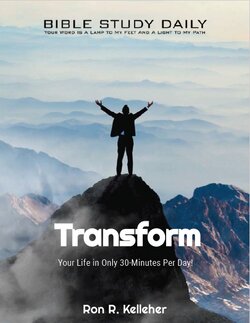There is a short introduction available for the book of Matthew. You can read it here.
Key Themes
The book of Matthew is the first Gospel in the New Testament and presents Jesus as the long-awaited Messiah and King of the Jews. It emphasizes Jesus’ fulfillment of Old Testament prophecies and His role as the teacher and savior of humanity. The Gospel of Matthew is structured around Jesus’ teachings, miracles, and the establishment of the Kingdom of Heaven. The key themes include:
- Jesus as the Fulfillment of Prophecy: A central theme in Matthew is that Jesus is the fulfillment of Old Testament prophecies concerning the Messiah. Matthew frequently references the Hebrew Scriptures to show how Jesus’ life, ministry, death, and resurrection align with what was foretold by the prophets. This theme underscores the continuity between the Old and New Testaments and affirms Jesus’ identity as the promised Savior.
- The Kingdom of Heaven: Matthew emphasizes the concept of the Kingdom of Heaven, which Jesus proclaims and embodies throughout His ministry. This theme focuses on the idea that God’s reign is breaking into the world through Jesus, offering a new way of life marked by righteousness, peace, and justice. The Kingdom of Heaven is both a present reality and a future hope, with Jesus calling people to repent and live according to God’s will.
- Jesus as the New Moses and Teacher: Matthew presents Jesus as a new Moses, a teacher who provides authoritative interpretation and fulfillment of the Law. The Sermon on the Mount (Matthew 5-7) is a key example, where Jesus offers deeper insights into the Law, focusing on the heart’s intentions rather than mere external compliance. This theme highlights Jesus’ role as the ultimate teacher and lawgiver, who brings God’s commandments to their fullest expression.
- Discipleship and Righteousness: Matthew places a strong emphasis on the demands of discipleship and living a life of righteousness. Jesus calls His followers to a higher standard of living, one that reflects the values of the Kingdom of Heaven. This theme includes teachings on humility, forgiveness, love for enemies, and the importance of inner purity over outward religiosity. Discipleship in Matthew involves total commitment to following Jesus and living out His teachings.
- Jesus’ Authority: The Gospel of Matthew frequently highlights Jesus’ authority over all aspects of life, including His authority over nature, illness, sin, and even death. Jesus’ authority is evident in His teachings, miracles, and the way He interprets the Law. This theme underscores that Jesus is not only the Messiah but also the sovereign Lord with power over all creation.
- The Mission to the Gentiles: While Matthew initially focuses on Jesus’ ministry to the Jewish people, the Gospel also emphasizes the expansion of the mission to include Gentiles. The Great Commission (Matthew 28:18-20) commands the disciples to go and make disciples of all nations, reflecting the inclusive nature of the Kingdom of Heaven. This theme highlights the universality of Jesus’ message and the call to spread the Gospel beyond Israel to the entire world.
- Conflict with Religious Authorities: Matthew records numerous conflicts between Jesus and the religious leaders of His time, particularly the Pharisees and Sadducees. These conflicts revolve around issues of authority, interpretation of the Law, and the true nature of righteousness. This theme illustrates the tension between Jesus’ teachings and the established religious order, ultimately leading to His crucifixion.
- Jesus’ Death and Resurrection: The Passion narrative in Matthew emphasizes the significance of Jesus’ death as the atoning sacrifice for humanity’s sins and His resurrection as the confirmation of His divine identity and the inauguration of the Kingdom of Heaven. This theme highlights the centrality of the cross and resurrection in Christian faith, offering hope of eternal life and victory over sin and death.
- The Church and Its Mission: Matthew’s Gospel also introduces the concept of the church (ekklesia) as the community of believers who continue Jesus’ mission on earth. Jesus gives instructions for church discipline, leadership, and the proclamation of the Gospel. This theme emphasizes the role of the church as the bearer of the Kingdom’s message and the responsibility of believers to live out the teachings of Jesus in community.
The book of Matthew is a richly theological Gospel that presents Jesus as the fulfillment of Jewish hopes, the authoritative teacher of righteousness, and the savior of all humanity. Through its emphasis on prophecy, the Kingdom of Heaven, discipleship, and the mission of the church, Matthew provides a comprehensive portrait of Jesus and His ongoing significance for both Jews and Gentiles. It calls readers to recognize Jesus as the Messiah, follow His teachings, and participate in the spreading of His Kingdom to all nations.
What I Noticed Today (Matthew 1-4)
Matthew 1


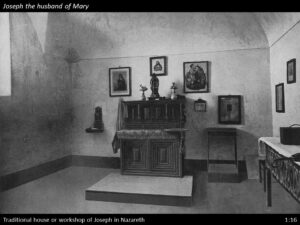
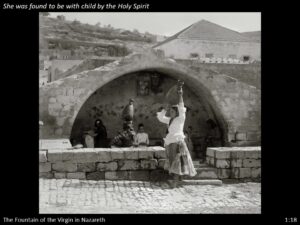

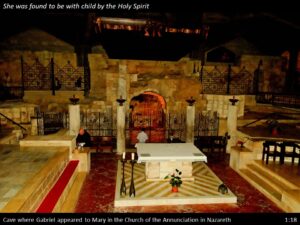
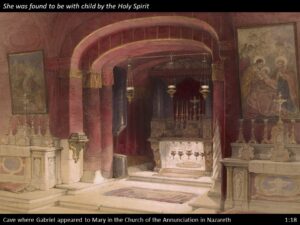
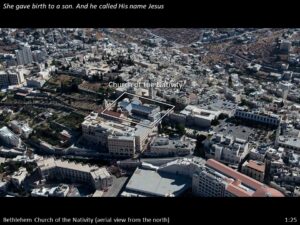

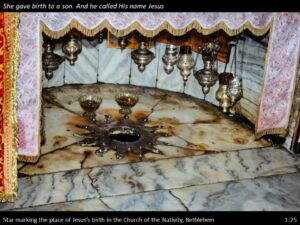
In verse 1, Matthew declares Jesus Christ as the book's focus, beginning with His lineage traced through Abraham and David.
In verses 2-17, Mathew presents the genealogy of Jesus through his legal father, Joseph. Matthew establishes Jesus as King.
- Abraham through David vv. 2-6a
- David through to Josiah vv. 6b- 11
- Jechoniah through to Joseph vv. 12-16
There were 14 generations listed from Abraham to David, 14 generations from David to Josiah and the deportation to Babylon, and 14 generations from Jechoniah to Jesus.
Note: There are four unusual aspects of the genealogy presented by Matthew: 1) it includes women (Tamar, Rahab, Ruth, Bathsheba, and Mary. Typically, Jews only trace lineage through the men.), 2) it includes bad people, 3) it includes Gentiles, and 4) it includes Rahab, a Gentile woman who was a prostitute.
Note: The listing says “the father of” all the way up to Mary which says “of whom Jesus was born,” indicating Mary as Jesus’ physical mother, but not Joseph as the physical father.
In verses 18-25, the birth of Jesus is described. Mary and Joseph were betrothed (engaged).
Note: In Jewish tradition, marriages were arranged. Once the “contract” was agreed to, the man and woman were betrothed and considered married. They were referred to as husband and wife but did not live together or have sexual relations. The betrothal period was one year after which a marriage ceremony was conducted, and the couple would begin their married life together.
During the one-year betrothal period, Mary was found to be with child, although she remained pure. Joseph decided to divorce her quietly but was told by an angel that the child was from the Holy Spirit. This fulfilled Isaiah 7:14: a virgin will conceive a son, and his name will be Immanuel (which means God with us).
Matthew 2



































In verses 1-12, Jesus’ infancy is described.
In verses 2-6, Jesus was born in Bethlehem during the days of King Herod. Wise men (gentiles) from the east came to Jerusalem asking where the king of the Jews was because they came to worship him.
Note: King Herod ruled from 37 B.C. to 4 B.C. Since Jesus was born during Herod’s rule, Jesus had to have been born during or before 4 B.C.
Herod was troubled by this. He assembled all the chief priests and scribes, asking where this child was born. They answered quoting Micah 5:2, a ruler who will shepherd the people of Israel will come from Bethlehem.
In verses 7-12, Herod secretly gathered the wise men together, asking when the star had first appeared, told them to go find this child so he could go worship the child. The wise men followed the star to Bethlehem, found Jesus, fell down, and worshiped him. They gave offerings of gold, frankincense, and myrrh. Then after being warned in a dream not to return to Herod left to return home.
Note: The Hebrew word translated house in verse 11 indicates they lived in a house, not a “stable,” as indicated in Luke 2.
Note: The three gifts offered by the wise men are significant: gold signifies his kingship, frankincense his priestly role, and myrrh is death (myrrh used for embalming).
In verses 13-15, an angel appeared to Joseph, telling him to take the family to Egypt because Herod was going to search for the child in order to kill him. Joseph complied, leaving leavening Egypt immediately. This fulfilled Hosea 11:1.
In verses 16-18, Herod realized the wise men had tricked him and ordered all boys in Bethlehem under two years old to be killed (presumably when the star appeared to the wise men). This fulfilled Jeremiah 31:15.
In verses 19-23, After Herod died, an angel appeared telling Joseph it was safe to return, so he brought his family back to Israel, settling in Galilee in the city of Nazareth.
Note: Matthew 2:23 refers to Nazareth as a fulfillment of what the prophets said. There is no direct Biblical reference to the prophets saying Jesus would be from Nazareth. However, Isaiah 4:2 and 11:1 refer to Jesse’s “branch.” The Hebrew word for branch includes the consonants nzr, which is also in the word Nazareth.
Matthew 3










Matthew 3 skips over the next thirty or so years of Jesus' life, resuming with the ministry of John the Baptist.
In verses, 1-3, John the Baptist in the wilderness of Judea preached a message of repentance for the kingdom of heaven is at hand. This fulfilled Isaiah 40:3.
In verses 4-10, many of the people came to John to be baptized. However, the Pharisees and Sadducees who heard him rejected his message.
In verses 11-12, John carried the message of repentance but believed he was unworthy to carry the sandals of the one who was coming (Jesus). While John baptized with water, Jesus would baptize with the Holy Spirit. John also warned that Jesus would winnow (separate) the wheat from the chaff (the believers from the unbelievers), and the chaff would be burned up (Malachi 4:1).
In verses 13-17, Jesus came to John at the Jordan river and asked John to baptize him. When Jesus was baptized and came up out of the water, the heavens opened, and the Spirit of God descended upon him like a dove, and a voice from heaven announced, this is my beloved Son with whom I am well pleased.
Note: John recognized that Jesus did not need to be baptized because his baptism was a baptism of repentance of confessing sins, and Jesus was without sin.
Note: The heavens opening, the descent of the Holy Spirit, and the voice of God are all validations of Jesus as Messiah, the Son of God, and mark the beginning of his earthly ministry.
Note: All three aspects of the Godhead are present at Jesus’ baptism: God the Father who speaks to His Son and the Holy Spirit who descends on Jesus.
Matthew 4















Matthew 4 records the temptation of Christ by Satan.
In verses 1-2, Jesus was led by the Holy Spirit into the desert (wilderness) to be tempted (tested) by Satan. After fasting 40 days and nights, Jesus was hungry.
Note: Interestingly, Jesus did not get hungry during the fast but after the 40 days and nights. Also, note the parallel with the spirit who led the people of Israel out of Egypt into the wilderness for 40-years.
In verses 3-4, Satan challenged Jesus to turn the stones into loaves of bread. Jesus answered, quoting Deuteronomy 8:3.
In verses 5-7, Satan took Jesus to Jerusalem to the pinnacle of the temple and said, throw yourself down; the angels will protect you. Jesus answered, quoting Deuteronomy 6:16.
Note: In tempting Jesus, Satan quoted from Psalm 91:11-12, taking the verse out of context (Satan is the deceiver!).
In verses 8-11, In Satan’s third test, Satan took Jesus to a high mountain showing him all the kingdoms of the world, promising that if Jesus worshiped him, he would give these kingdoms to Jesus. Jesus answered, quoting Deuteronomy 6:13 and 10:20.
With that, Satan left Jesus, and the angels came to minister to him.
Note: Satan’s temptations of Jesus are similar in nature to his temptations of Eve. Satan tempted both with an appeal to their physical appetite, with an appeal to personal gain, and with an appeal to power.
In verses 12-17, Jesus heard that John the Baptist had been imprisoned, so Jesus left Nazareth and went to Capernaum in the territory of Zebulun and Naphtali. This fulfilled Isaiah 9:12. Jesus’ public ministry began as he preached repentance for the kingdom of God is at hand.
In verses 18-22, Jesus called the first disciples Simon (Peter) and his brother Andrew who were fishermen, to become fishers of men. Immediately they left their nets and began to follow Jesus. From there, Jesus called James the son of Zebedee and his brother John who were also fishermen, and they also left their nets and boats and immediately followed Jesus.
Note: This was not Jesus' first meeting with these men. See John 1:35-42.
In verses 23:25, Jesus went throughout all of Galilee teaching in the synagogues, proclaiming the gospel, and healing disease. News of his ministry spread throughout Syria (north of Galilee). Jesus healed all those who came to him. As a result of his ministry, great crowds from Galilee, Decapolis, Jerusalem, Judea, and the region west across the Jordan River.
Note: The reference to “Decapolis” is a region of 10 largely Gentile cities south of the Sea of Galilee. It is important to note, even in the beginning, Jesus’ ministry was to both Jews and Gentiles.
What did you notice in your study today? Feel free to visit the website and leave a question or a comment.

